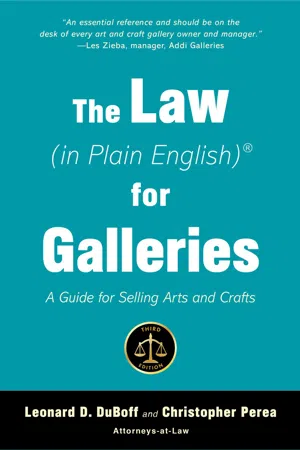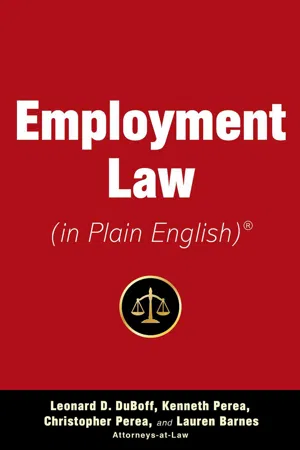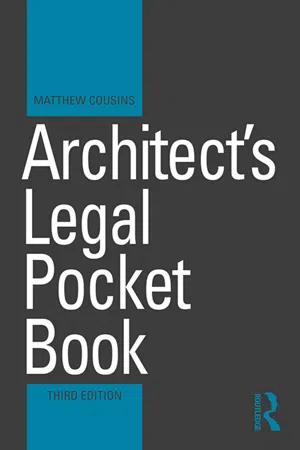Law
Types of Contract
Types of contracts include express contracts, which are explicitly agreed upon by all parties; implied contracts, which are inferred from the conduct of the parties involved; and unilateral contracts, where one party makes a promise in exchange for an act from another party. Additionally, there are bilateral contracts, which involve promises from both parties, and void or voidable contracts, which are unenforceable for various legal reasons.
Written by Perlego with AI-assistance
6 Key excerpts on "Types of Contract"
Learn about this page
Index pages curate the most relevant extracts from our library of academic textbooks. They’ve been created using an in-house natural language model (NLM), each adding context and meaning to key research topics.
- eBook - ePub
Islamic Financial Contracts
A Research Companion
- Hussain Mohi-ud-Din Qadri, Nasir Iqbal(Authors)
- 2021(Publication Date)
- Routledge(Publisher)
12 Classification of contractEarly jurists and legal experts classified the contracts concerning several perspectives and explained them by assigning them different terms and names. Much literature is available on these classifications of the contracts. While describing the categories, independent legal reasoning and the various perspectives of contracts were kept in view by the learned jurists.A cursory review of the academic literature shows that the early as well as modern jurists, while discussing the various classification of contracts, classified a contract according to its nature, circumstances, legal consequences, functions, purposes and according to its time of completion, etc.12.1 Classifications of the contract according to its nature
Most Muslim jurists have classified contracts according to their nature, including whether they are Shariah -compliant or contain some prohibited elements such as interest-bearing, deceptive, speculative or fortuitous elements. The nature of a contract is considered in line with explicit provisions in the texts used to assess the legality or otherwise of certain contractual transactions. This classification includes unilateral contracts (‘aqd infiradi ), bilateral contracts (‘aqd thuna’i ), quasi-contracts (shibh al-‘aqd ) and joint contracts or multilateral contracts.12.2 Unilateral contract (‘aqd infiradi)A unilateral contract is defined as a transaction by one party only, or by which one party binds himself.1According to another source, a unilateral contract is:One in which the offeror promises to pay for an act done by the other party, the acceptance takes the form of performing the act. The offer and resulting contract are unilateral, that is, one-sided because only one party makes a promise.2Hence a unilateral contract is considered as a one-party transaction, i.e. which is made by a single person who intends to establish a form of legal relationship with another party through a promise. Such a promise is a self-imposed contract and becomes binding on the person who makes it. It only becomes binding on the person in whose favour it has been made once he or she accepts the promise. A typical example of a unilateral contract is a promise made by somebody in the form of a reward for whoever does something or finds a missing thing. Such reward (ju’alah - eBook - ePub
The Law (in Plain English) for Galleries
A Guide for Selling Arts and Crafts
- Leonard D. DuBoff, Christopher Perea(Authors)
- 2020(Publication Date)
- Allworth(Publisher)
CHAPTER 7 ContractsContracts are an essential part of virtually every business. Clearly, the entire field of contract law cannot be covered here but, by becoming aware of some of the potential consequences of contract law, you will see where you need to be cautious.CONTRACT BASICSA contract is a legally binding promise or set of promises. The law requires that the parties to a contract perform the promises they have made to each other. In the event of nonperformance—usually called a breach—the law provides remedies to the injured party. For the purposes of this discussion, it will be assumed that the contract is between two people, though it frequently involves business organizations, as well. It should be noted that when business organizations are involved, there are additional considerations, such as whether the person acting on behalf of the business has appropriate authority, how that authority must be evidenced, and, regardless of authority, whether that individual’s act will be deemed within the appropriate scope of the business. These issues complicate the analysis. Contracts can be very complex and involve a great deal of detail. Even if some provisions of a contract are not complied with, the contract may still be enforceable. In Hoffman v. L&M Arts , decided in 2016, Marguerite Hoffman, owner of a valuable Mark Rothko painting known as “the Red Rothko,” sued the gallery L&M Arts for breach of contract. The case involved a number of technical issues involving contract provisions such as confidentiality, misrepresentations, and the proper identification of the parties involved, underscoring the importance of working with an experienced art lawyer if at all possible.The three basic elements of every contract are the offer, the acceptance, and the consideration. To illustrate these elements, suppose a salesperson shows a customer an oil painting at your gallery and suggests that the customer buy it (the offer). The customer says he or she likes it and wants it (the acceptance). They agree on a price (the consideration). That is the basic framework, but a great many variations can be played on that theme. - eBook - ePub
- Leonard D. DuBoff, Kenneth A. Perea, Christopher Perea, Lauren Barnes(Authors)
- 2021(Publication Date)
- Allworth(Publisher)
CHAPTER 3 Basics of ContractsContracts are an essential part of virtually every business for both employees and employers. Clearly, the entire field of contract law cannot be covered here, but, by becoming aware of some of the ramifications of contract law, you will see where you need to be cautious. In this chapter we will cover contract fundamentals. In later chapters we present specific kinds of employment contracts.CONTRACT BASICSA contract is a legally binding promise or set of promises. The law requires that the parties to a contract perform the promises they have made to each other. In the event of nonperformance—usually called a breach—the law provides remedies to the injured party. For the purposes of this discussion, it will be assumed that the contract is between two people, though it frequently involves business organizations, as well. It should be noted that when business organizations are involved, there are additional considerations, such as whether the person acting on behalf of the business has appropriate authority, how that authority must be evidenced and, regardless of authority, whether that individual’s act will be deemed within the appropriate scope of the business. These issues complicate the analysis. You should discuss these issues with your attorney.The three basic elements of every contract are the offer, the acceptance, and the consideration. To illustrate these elements, suppose a human resources manager meets with a prospective employee and explains what employment opportunities are available in the company (the offer). The prospective employee says that the job presented is perfect and acceptable (the acceptance). They agree on a salary (the consideration). That is the basic framework, but a great many variations can be played on that theme.Types of ContractS Contracts may be express or implied. They may be oral or written. There are generally at least two Types of Contracts that must be in writing if they are to be legally enforceable: - eBook - ePub
- Matthew Cousins(Author)
- 2019(Publication Date)
- Routledge(Publisher)
6General principles of contract lawStatutes
- Consumer Rights Act 2015
- Local Democracy, Economic Development and Construction Act 2009
- Companies Act 2006
- Consumer Credit Act 2006
- Contracts (Rights of Third Parties) Act 1999
- Housing Grants, Construction and Regeneration Act 1996
- Limitation Act 1980
- Unfair Contract Terms Act 1977
- Misrepresentation Act 1967
WHAT IS CONTRACT LAW?
“The law of contract provides the principal framework for the legal analysis of rights and obligations arising out of agreements for the carrying of construction or engineering work.”11 Bailey, J., 2011, Construction Law, Vol 1, Informa Law, p 4.Contract law is the law that regulates contracts. In general terms, contract law can be described as a body of rules of agreement based on the mutual exchange of obligations. For there to be formation of a contract, different parties must reach agreement, the agreement must be supported by consideration and there must be an intention to create legal relations. A contract can be created orally, by exchange of letters, fax or email, or be the outcome of a period of negotiation, exchange of promises or conduct of the parties. The parties to a contract are free to agree the obligations to which they wish to be bound and, once a contract is concluded, it binds the parties in law. It is often preferable to have a formal written contract signed by both parties.WHAT IS A CONTRACT?
A contract is an agreement giving rise to obligations which are enforced or recognised by law. The factor which distinguishes contractual from other legal obligations is that they are based on the agreement of the contracting parties.22 Treitel, G., 2003, The Law of Contract, 11th edn, Sweet and Maxwell, p 1.A contract is a legally binding agreement that creates rights and obligations between two or more parties that can be enforced by law. Contracts are a body of rules of agreement based on the mutual exchange of obligations. The law of contract provides the principal framework for legal analysis of rights and obligations arising out of agreements for carrying out construction or engineering work. Contracts also provide a means of adjusting the rights and obligations of the parties. Under a contract, architects usually have a duty to comply with relevant standards and regulations. Under section 104 of the Housing Grants, Construction and Regeneration Act 1996 a construction contract has a statutory definition, meaning an agreement with a person for: - eBook - ePub
Saudi Business Law in Practice
Laws and Regulations as Applied in the Courts and Judicial Committees of Saudi Arabia
- Frank E Vogel(Author)
- 2019(Publication Date)
- Hart Publishing(Publisher)
6 Contracts: General Categories and Specific Types6.1. Two Conceptions Applying Across Many Contracts6.1.1. Binding versus Revocable Contracts, Lāzim versus Jā’iz6.1.2. Relationship to the Property of Another that One Holds by Contract: Amāna and Ḍamān6.2. The Nominate Contracts, or the Contracts Regulated in Detail by the Traditional Law6.2.1. Commutative, Synallagmatic, Mutually Onerous Contracts6.2.2. Gratuitous Contracts6.2.3. Accessory Contracts6.3. Case Study on Consequences for Third Parties of the Saudi Law and Practice of Agency and Representation6.3.1. Solutions in Fiqh Doctrine6.3.2. Solutions through Local Administrative Mechanisms6.3.3. Some ConclusionsIn this chapter, I introduce the forms of contract that were worked out in detail in the traditional fiqh, and which remain even today the models against which new contracts are tested for conformity with Sharia.1 Almost any contract one can conceive of in a business context will overlap with one or more of these contracts, and thus inevitably engage analogies to the rulings that apply to these model contracts. It is always possible for scholars to argue that a business context and the contracts it generates are unprecedented and require novel ijtihad from fiqh’s original sources, and should not be judged solely by analogies to these contract forms. Scholars can invoke the principle that in human interactions (mu`āmalāt) permissibility is the original state (al-aṣl - eBook - ePub
- Chris Monaghan(Author)
- 2015(Publication Date)
- Routledge(Publisher)
Chapter 3Contract lawLEARNING OBJECTIVESAfter reading this chapter, you should be able to:• appreciate the requirements that are needed in order to have a legally enforceable contract;• understand the consequences for the contracting parties where there is misrepresentation, mistake, duress, illegality and undue influence;• comprehend how a contract can be discharged by performance, acceptance, breach and frustration;• demonstrate an awareness of the remedies that are available where a contract has been breached.Every business transaction will involve the use of a contract. Without a contract, a business agreement will not be legally enforceable. This chapter is intended as an introduction to the law of contract. It is essential that you understand the key concepts covered in this chapter. To demonstrate how the law applies in practice we will consider how the law relates to transactions entered into by Snow Ltd. Snow Ltd is based in York and specialises in building loft extensions. Imagine that Snow Ltd wishes to contract with Murphy Ltd, in which case the contract could be written or verbal. Both written and verbal contracts are equally valid. However, in an event of a dispute, it will be easier to prove the terms of the contract if the contract is written. When advising Snow Ltd this would be a point that you would make; alternatively, if you were a director of Snow Ltd, you would appreciate the advantages of recording the terms of the contract in writing.





